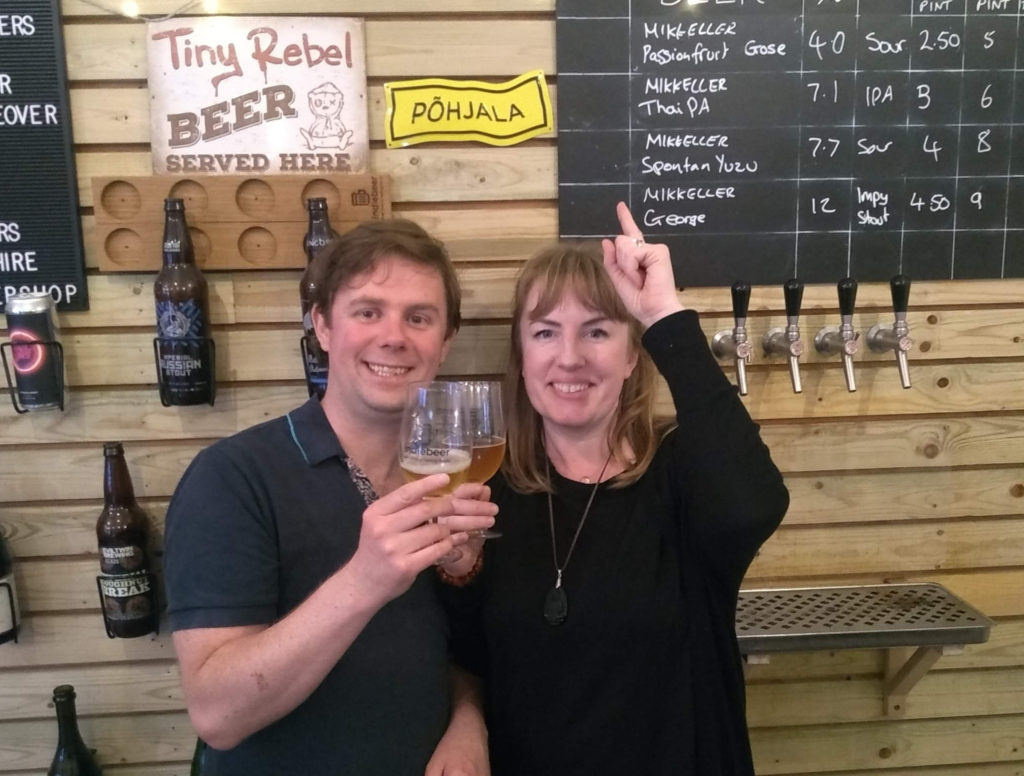ECA columnist and Retail Insider editor Glynn Davis meets Owen & Clare Daniel, co-owners, Indiebeer…
Can you tell us a little about Indiebeer?
Indiebeer is a speciality craft beer shop and taproom that we set up in 2017, with a focus on modern beers while retaining a connection to classic European styles. We are a hybrid business, operating as a shop, taproom and online store. We have four rotating beers on draught, and 10 fridges holding around 400 beers, which are set at the optimal temperature for each beer style.
We are passionate supporters of independently-owned and managed breweries, hence the name. You won’t find any Stella or Heineken here! We pride ourselves on offering only the finest, most sought-after, and carefully vetted independently brewed beers from the UK and worldwide.
Our venue itself and the incredible community of regulars that we spend so much time with are an important part of who we are. Indiebeer is a comfortable, relaxed place with a welcoming, non-pretentious and all-inclusive vibe where you can while away the hours sampling an incredible selection of amazing brews.
What were the key drivers for creating the business?
We are a husband/wife team and, as massive beer lovers, spend a lot of our time exploring various craft beer venues in London and around the world. We fell in love with the Beer Shop/Bar hybrids that we discovered in the USA. These are proper drinking-in venues with loads of space and seating, with as much of a focus (and often more) on the taproom as the shop itself. This sort of model was relatively rare in London at the time, particularly in North London where we are based, so we decided to create somewhere where we’d love to drink ourselves! This is all complemented with the online store.
What type of customers do you attract and how do you attract them?
Good question, and much better than the more common question, which is what your customer demographic is. On any given day we see a multitude of different age ranges and backgrounds.
The common connection between our customers is that they are curious and enjoy trying new things, whether that be in beer, food, or life more generally. We use the terms Beer Explorer and Beer Geek a lot. Both share the commonality that they are looking for excitement in their beer. Of course, we have some customers who know what they like and stick to that, but they are few and far between, and even they sometimes like to go off on a little beer adventure every once in a while.
In terms of how we attract our customers in such a competitive market, word of mouth wins every time. We are incredibly lucky to have so many customers leave us fantastic online reviews. Social media is free and is a great way to communicate our personality. We will be the first to admit we could do more of this and could do definitely do it better, but it can sometimes be quite draining to put yourself on a pedestal, and you have to be in the right mindset for it.
It’s a very competitive market so what would you say are your USPs?
When we first opened, we had a few very clear USP’s, and over time many of those have become the industry standard. For example, refrigerating all stock (essential to preserve freshness, so the flavour profile of the beer remains as the brewer intended), and separating beers by beer style (as opposed to brewery which was often the case back then).
One thing that we are still relatively unusual in is our insistence on only stocking independently managed breweries. We strongly believe (for a multitude of reasons) that this is the right thing to do. Whatever your personal views, we think it’s a USP that helps us to stand out from the crowd and demonstrates that we are here for the wider beer community.
We also as much as possible try to mirror our in-store experience on our webstore. For example, we segment beers as much as possible to make navigation easy e.g. we group beers by beer style and alcohol content and flag which are vegan. We also guide customers as much as possible, sharing our expertise through a guide to beer styles and writing detailed descriptions for every beer. Customers can also contact us with any queries via a live chat function. The customer experience we offer is constantly evolving.
How important is it to also have a physical shop/bar?
It is absolutely essential. Even more so in recent years as competition has increased and breweries set up webshops during Covid-19, as well as a proliferation of online-only beer shops.
Our online business boomed at the start of Covid-19, but now we are seeing a big shift to on-trade drinking rather than off-sales. Without a physical presence those sales might have fizzled out entirely.
There are myriad ways that our physical store benefits the e-commerce store. Customer reviews being the first that springs to mind. If we were online-only our reviews would mostly relate to the delivery aspect of our service. However, the reviews we get for the physical store confirm that we are experts in our field offering a wealth of knowledge and outstanding customer service.
Trust, now more than ever, is an important part of our customers’ buying process and having a physical address and knowing that the people working there are likely to have tried the product goes such a long way. We can hand on heart say that we wouldn’t stock a drink that we didn’t think was good enough and we think that comes across in our website and reviews.
Shoppers that visit our store also often place subsequent orders online. Over the festive period in particular, many customers who visited our store went on to place orders for beers to be delivered either to their house or that of family members, ready for Christmas.
How much of revenues are generated from the shop/bar?
This is constantly changing, but we can say that for the past year share of sales from the online store has dropped by nearly 50%. We would never prioritise one channel over the other as there is so much customer overlap. We deliver orders to local addresses ourselves by cargo bike and these are often to drink-in customers. We also have many customers who place online orders as gifts for family members. The two sales channels really do complement each other.
If someone visits us for a drink, there is a good chance they are going to take something away with them as well, which is where our hybrid model really comes into its own. We estimate that approximately one third of our in-store sales originate from customers drinking-in.
Can you share any other numbers – sales, number of repeat customers, number of beers stocked etc..?
We won’t go into sales figures but we are happy to say that around one third of our customers are repeaters and are becoming even more important to us over time. We stock around 400 beers at any one time although the mix changes constantly. This is because over half of the beers we stock are one-off’s and also beer is very seasonal (we stock more darker beers in winter and lighter beers in the summer). We have recently increased our focus on natural wines and meads.
What challenges have you faced and what elements have you had to adapt?
We will avoid the obvious elephant in the room that was Covid-19 as every business had challenges to face there. If you came out the other side it generally means that was a result of learning very quickly to pivot and adapt, often on a month-by-month basis. It’s the post-Covid-19 world that is proving to be more challenging for us.
Running costs are our biggest challenge right now. Having 10 fridges and keeping a stock room cool is very expensive. Our electricity costs alone will have increased sevenfold by summer this year. We are having to work even harder to grow sales to offset this. Ask us again at the end of the year if we have overcome that hurdle.
We have so many more ideas about what we’d like to do to grow further and particularly to make our drinking-in experience even better in 2023 – watch this space!
What is the greatest opportunity for the business?
Right now, the focus is going to mostly be in-store. And while we’re not sure it’s an opportunity, rather a do-or-die, we need to continue to make our venue more appealing for people to visit. Giving people reasons to come back is more crucial than ever. When we get the physical shop right, we also tend to see growth in online sales. It is very important for us to make sure that everyone who walks in the door knows that we also sell online, and for every website visitor to know that they can come and visit us.
What plans do you have for the future?
There’s plenty in the pipeline, including several improvements to the website, but we are very much at the planning stage as we speak, so we’d rather not commit or give too much away this early in the year!










